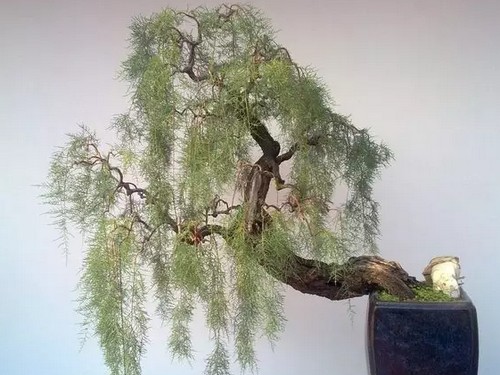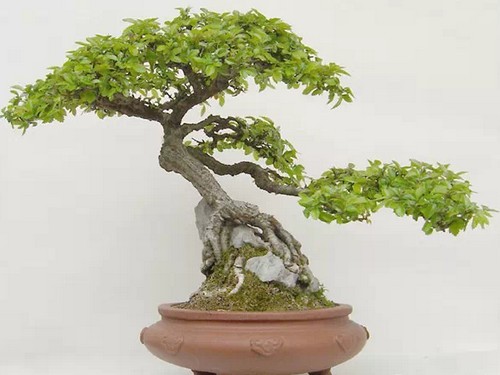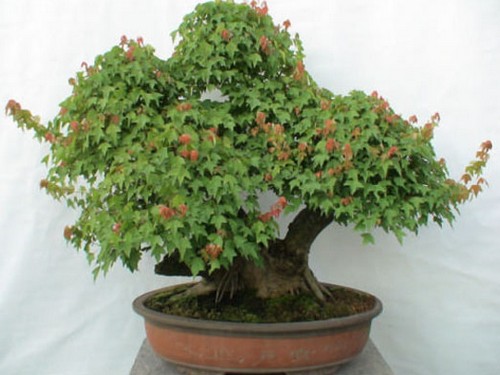The modeling method of strange willow bonsai
Tamarix is shaped as the trunk of Guiqu, with sparse branches, dense flowers and leaves, and dewy roots. Tamarix should be dry, buckled and cracked. Tamarix sprouting ability is very strong, through pruning to remove the sprouts on the trunk in time, so that its scars accumulate, mottled. Strange willow branches are soft and drooping and can be pruned and tied to form weeping or semi-drooping bonsai.

The old branches of Tamarix are brittle and easy to break, so they should be pruned mainly. The branches of the same year are relatively soft and can be combined with binding on the basis of pruning. Twigs can be cut into films, which should be reasonably distributed in space, scattered with each other, and the top of the film should be natural. The haircut begins about half a month after the early spring bud sprouts, and can be trimmed again after 20 days. The top branch should be semi-oval and flat, and the middle and lower branches should be pressed downwards, echoing the top branch and the natural tree potential, and complementing each other. The longer or improperly positioned branches can be banged and pulled with lead wire, and then remove the lead wire after the curvature is fixed.
Tamarix in modeling pruning is generally seen in the form of weeping branches, but the difficulty lies in the production of weeping branches when doing natural modeling. Because Tamarix grows in nature, the new branches are most likely to grow upward. Branchlets and side branches are most likely to droop, so when making hanging branch bonsai modeling, the branches can not be allowed to grow freely, but the position, number, density, length, thickness, hierarchical change and overall outline of the drooping branches should be determined according to the requirements of the layout. If we can correctly apply the methods of early branch fixing, shading treatment, pulling branches and thinning side branches, good results can be obtained.
Tamarix has strong germinating ability, and most of the sprouts are in the shape of clusters, so sprouts should be wiped and fixed in time according to the design intention. Pruning, renewing old branches and increasing flowering times should be done in time after flowering.
Tamarix root is a deep root, the root is well developed, shallow planting method or root lifting method can be used to make the root uplift to reveal the soil surface, high and low, thick and thin, staggered qu, highlighting its natural beauty.
Tamarix grows fast and is pruned once a week in spring and summer in order to maintain the tree shape. For the new buds sprouting on the trunk, those who are not in need of modeling should be removed in time so as not to consume nutrition. In order to improve the ornamental ability of Tamarix, we can take advantage of its strong germinating ability, remove all the leaves in the vigorous growth period, then put them in the place of sufficient sunshine, strengthen the management of fertilizer and water, spray water on the branches once in the morning and evening, sprout new buds in 5 to 6 days, and the leaves are plump and green in 20 days.
1. Hanging branch type
First of all, we should choose a suitable trunk, such as oblique dry, crooked dry. The second is to cultivate the first, second and third grade main branches. in order to simulate, the main branches should be raised oblique and upward, and the flat branches should be cultivated as few as possible, because weeping willows in nature rarely have large flat branches. After the main branch skeleton is cultivated, when the new buds grow to 3 cm, leave the strong buds needed for modeling and erase all the useless buds. When the remaining buds grow to 15 cm, that is, after the lateral buds are born, cut off 10 cm of the main bud branches and retain only 4 cm and 5 lateral buds. When the retained lateral buds grow to 20-25 cm, remove too weak and too short branches, and cut off too thick, too long and too dense branches, that is, remove the "five over" branches and leave enough suitable branches for modeling. Then pull the branches that are not in place with wire, or use heavy objects to fall for 6 or 10 days to set the shape.
2. Imitation of pine cypress type
Tamarix has not only bark like pine and cypress branches, but also leaves similar to its leaves. Imitation pine and cypress shape, first of all to choose the trunk is tall and straight, vigorous and aggressive. Then pay attention to the cultivation of flat branches or oblique floating branches, the main branch near the trunk properly leave the length not to do leaves, in order to show that it is old, so that its skeleton is similar to the pine and cypress skeleton. Finally, the production of leaves, each piece of high and low scattered, there are pieces in the film, there are flowers in the flowers, and strive to be similar to the leaves of pine and cypress.
3. Natural styling
The natural style leaves twigs too short, 10-15 cm. No external force is needed to make it grow naturally, and its branches and leaves droop slightly, which is similar to parabola.
Time: 2019-06-11 Click:
- Prev

Modeling method of Lang Elm Bonsai
When buying nut elm bonsai, you must look at the pile carefully. The more fresh the pile billet is, the better. Don't think that the decaying pile has more charm, and some even the root system is not growing well. Novices should let the nut elm survive first and do the modeling slowly. The processing and modeling of elm can be carried out by the combination of pruning and climbing.
- Next

How to prune the bonsai of Triangle Maple
The triangular maple tree is graceful, the leaf shape is beautiful, the leaf tip is three-lobed, just like duck flippers, it is quite ornamental. At the beginning of spring, the new leaves are beautiful and green; after autumn, the leaves turn to dark red or old yellow, which is more pleasing to the eye. For example, in late summer and early autumn, the old leaves are picked and applied with a quick-acting nitrogen fertilizer, and fresh and tender leaves are sent out half a month later.
Related
- Fuxing push coffee new agricultural production and marketing class: lack of small-scale processing plants
- Jujube rice field leisure farm deep ploughing Yilan for five years to create a space for organic food and play
- Nongyu Farm-A trial of organic papaya for brave women with advanced technology
- Four points for attention in the prevention and control of diseases and insect pests of edible fungi
- How to add nutrient solution to Edible Fungi
- Is there any good way to control edible fungus mites?
- Open Inoculation Technology of Edible Fungi
- Is there any clever way to use fertilizer for edible fungus in winter?
- What agents are used to kill the pathogens of edible fungi in the mushroom shed?
- Rapid drying of Edible Fungi

